pa-dirt_nc-sand
Silver Member
- Joined
- Apr 18, 2016
- Messages
- 4,267
- Reaction score
- 15,088
- Golden Thread
- 2
- Location
- South Western PA
- 🥇 Banner finds
- 2
- 🏆 Honorable Mentions:
- 2
- Detector(s) used
- ACE 250 with DD coil
Equinox 600
- Primary Interest:
- Metal Detecting
99% of the time I am darting into the old park wooded areas searching for lost farmsteads I’ve researched. My latest site is in the middle of a vast field.
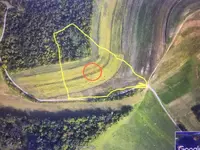
My first hunt was to verify the location of the old 1850ish site and searched directly in the middle. This post is about my second visit. I tried expanding out to the yellow lines that I determined to have been home land vs farm field 150 years ago. I sort of just randomly zigged and zagged and found keepers about every 10 minutes, but definitely felt chaotic in my approach. Sort of how I beach detect. Find a keeper, expand out on a 10’ radius then go random direction again.
Here are the buttons
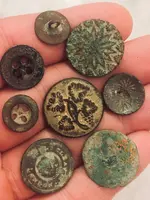
I rarely find floral or pattern buttons so the snowflake and flower with gilding were pleasant surprises. This little one is a 2 hole button made from tombac with carved pattern, any ideas on this?
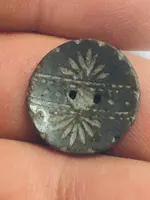
Couple of interesting finds.
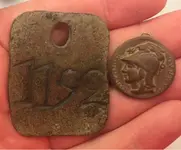
The tag is really thick and the goddess is stamped brass with Roman script, my guess circa 500 BC or 1920’s fashion accessory.
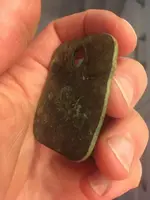
Handful of miscellaneous
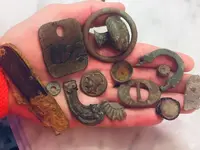
And a handful from a quick hunt at lunch
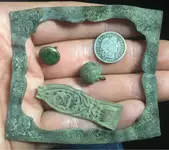
Cuff link is jade I believe. Zouave button, or in W PA just a ball button and finally a Barber Dime!
Good luck out there!

My first hunt was to verify the location of the old 1850ish site and searched directly in the middle. This post is about my second visit. I tried expanding out to the yellow lines that I determined to have been home land vs farm field 150 years ago. I sort of just randomly zigged and zagged and found keepers about every 10 minutes, but definitely felt chaotic in my approach. Sort of how I beach detect. Find a keeper, expand out on a 10’ radius then go random direction again.
Here are the buttons

I rarely find floral or pattern buttons so the snowflake and flower with gilding were pleasant surprises. This little one is a 2 hole button made from tombac with carved pattern, any ideas on this?

Couple of interesting finds.

The tag is really thick and the goddess is stamped brass with Roman script, my guess circa 500 BC or 1920’s fashion accessory.

Handful of miscellaneous

And a handful from a quick hunt at lunch

Cuff link is jade I believe. Zouave button, or in W PA just a ball button and finally a Barber Dime!
Good luck out there!
Upvote
19




